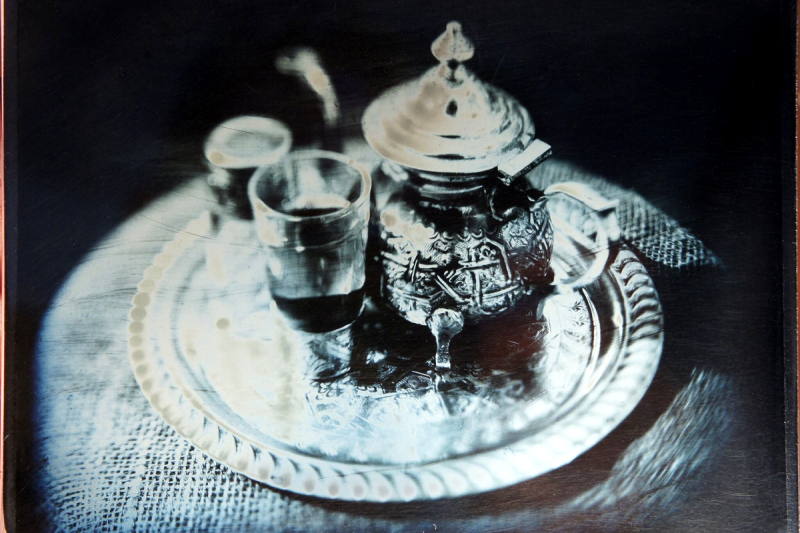The Daguerreotype was among the earliest photographic processes, long before glass plates or film, that relied on sensitizing a thin layer of silver on top of a copper plate. The earliest Daguerreotype plates were made physically, by rolling a copper-silver plate thinner and thinner until the silver layer was just right. Good luck finding a source of Daguerreotype plates made this way in 2022. (There are electroplating methods, but they all end up with chemically contaminated silver.)
On the other hand, magnetron sputtering is a process of depositing pure metal in thin layers using plasma, high voltages, and serious magnets, and [Koji Tokura] is making his own sputtered Daguerreotype plates this way, giving him the best of both worlds: the surreal almost-holographic quality of the Daguerreotype with the most difficult film preparation procedure imaginable.
 The star of the show is [Koji]’s sputtering rig, which consists of a Tupperware glass sandwich box as a vacuum chamber and a microwave oven transformer as the high voltage source. In use, he pumps the chamber down, introduces a small amount of argon, and then lights up the plasma. The high voltage accelerates the plasma ions into a sheet of silver, and the silver particles that get knocked free coat the copper plate. A strong magnet creates a local plasma, which accelerates the coating procedure, but since [Koji] only had a relatively small magnet, he scans the plate with the magnet, using a scavenged 2D pen plotter mechanism.
The star of the show is [Koji]’s sputtering rig, which consists of a Tupperware glass sandwich box as a vacuum chamber and a microwave oven transformer as the high voltage source. In use, he pumps the chamber down, introduces a small amount of argon, and then lights up the plasma. The high voltage accelerates the plasma ions into a sheet of silver, and the silver particles that get knocked free coat the copper plate. A strong magnet creates a local plasma, which accelerates the coating procedure, but since [Koji] only had a relatively small magnet, he scans the plate with the magnet, using a scavenged 2D pen plotter mechanism.
Check out his video on the Hackaday.io page, and his Daguerreotype gallery as well. (We don’t think that they were all made with this procedure.)
The result is a chemically pure Daguerreotype plate produced in a seriously modern way, and we’d love to see the images in person. In these days of disposable images made by the AIs in your cell phone, it’s nice to see some people taking photography in strange directions. For instance, maybe you’d like to make your own ultra-large collodion plates. Or something else? If you do, show us!















Begorrah!
Very impressive! Also, that tech could be used for so many other things besides photography.
I used to have access to a sputter coater when I was using electron microscopes as part of my PhD.
I platinum coated some contact lenses for a friend. It was a very odd look.
Was the coating thin enough for them to see through?
Yes, just like mirrored sunglasses.
Which seems different to the ones that can be found with a Google search, which seem to have a clear pupil area
Just to be clear, the OP here didn’t invent magnetron sputtering. It’s from the 70s or 80s and is the shizz in industry for making relatively thick coatings b/c you can ablate the bits closer to where they need to land, producing a much higher yield.
This is, however, the coolest DIY magnetron sputtering setup I’ve ever seen.
You left out the part about using mercury vapor to develop the image after it is taken on these plates.
Yeah. I don’t know what he’s developing these with. Is that the only chemistry? It’s certainly the classic one.
You’d want to keep that stuff well contained…
Hi, I’m the creator of this device.
See this discussion on daguerreotype development and mercury.
Have a nice Sunday!
https://goo.su/ZfuU
Sputter coating inherently creates x-rays. Old school sputter coaters were made similiar to a bell jar with the precious metal at the top of the jar. The new style are fully enclosed so as to be safer for the operator. Sputter coaters are used to coat scanning electron microscope samples before imaging. The samples are typically coated with gold or platinum.
1500v is nowhere near enough potential to create x-rays.
There would be no hard X-rays and any soft X-rays generated should be heavily attenuated by the glass and surrounding air. But depending on the quality of the vacuum Bremsstrahlung should generate soft X-rays inside the device.
soft X-rays: ~10nm to ~0.2 nm (~124 eV to ~6200 eV)
At the low powers used, I’d be pretty happy relying on inverse-square for minimising dosage (i.e. take a few steps back when active).
Hi, I’m the creator of this device.
There were concerns about the traditional mercury vapor development of daguerreotypes, so I will explain the current situation.
Possibly in the EU area, I think that it is the direction to ban the possession of mercury itself.
Therefore, the current daguerreotype author should proceed in the direction of replacing it with the Becquerel method.
For details of the Becquerel method, please refer to the following URL.
https://bit.ly/3QSXucH
Quite simply, just bask the plate through an amber filter.
In the case of this development method, the most toxic chemical in the entire process is iodine, and it can be safely worked with as long as general handling etiquette is observed.
And my daguerreotype shown here was developed by the Becquerel method. :)